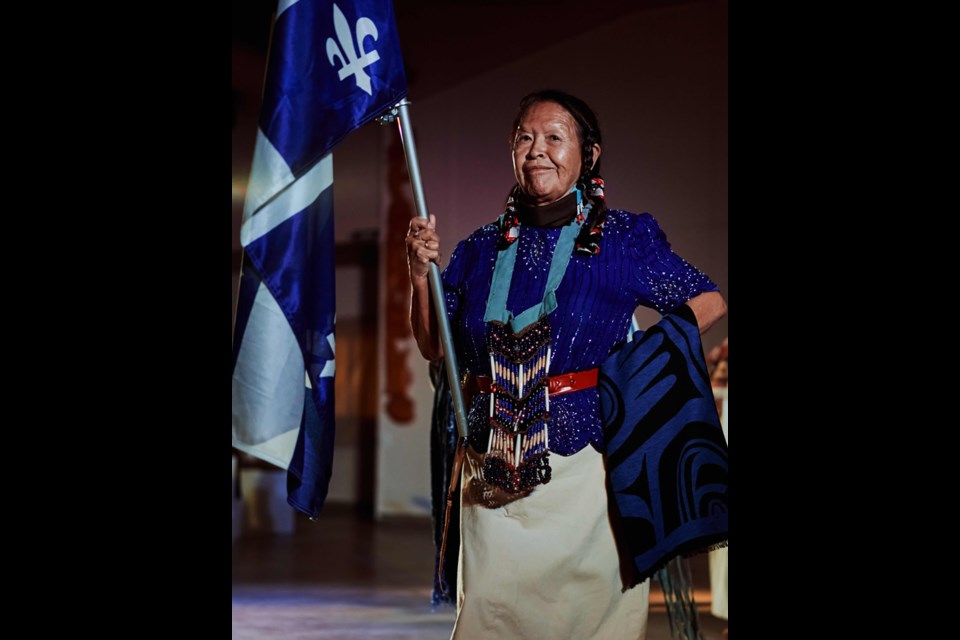Themes of Reconciliation and multiculturalism, and the unexpected overlaps between South Asian and First Nations cultures, were explored on stage recently in a powerful multi-media performance celebrating diversity and decolonization.
Buffalo Dreaming — a live performance mounted by the Sunshine Coast Dance Society — made its debut during the recent Sechelt Arts Festival. Co-produced by a Secwépemc cultural leader, artist and Elder Mary Thomas, and Meera Shah, a Sunshine Coast artist and choreographer classically trained in India, the performance was aimed at educating and inspiring both audience and performers.
“It’s about awareness and understanding and harmony, and bringing together different ethnic groups and cultural norms in dancing, in music and drumming,” says Diana Robertson, society president, of the performance. “It’s a critical message, especially for youth, about being more aware of our multicultural neighbours. It’s a story that needs to be nurtured.”
That message also aligns closely with TELUS’ own commitment to Indigenous Reconciliation, diversity and inclusion, and caring for the well-being of communities across the country.
It’s why the company supports the Sunshine Coast Dance Society, contributing $7,500 to help ensure the dance society is able to explore, create and perform its powerful programming.
“The TELUS funding was critical,” says Robertson, adding it was used to offset the cost of a projectionist and expand the scope of the performance, and allowed more dancers to participate in the production.
Buffalo Dreaming brought together Knowledge Keepers, musicians and youth and adult dancers from the shíshálh (Sechelt) and Secwépemc (Williams Lake) First Nations, as well as those from the local South Asian community.
Through choreography, images and narration, dancers explored the cultural similarities and differences between India and West Coast and Cariboo-Chilcotin First Nations — from the impacts of colonialism to celebrating the importance of traditional lands, the sacred buffalo and the power of dance.
With a focus on “dance, decolonize and repeat,” Robertson says the hope is the performance will be as educational as it is captivating to experience.
The all-ages performance featured five youth and 15 older dancers, ranging in age from 30s to 70s. About one-third, including a hoop dancer, were from Cariboo-Chilcotin, while the rest were from the shíshálh nation, the Sunshine Coast area and Surrey.
The dance society, which will celebrate its 30th anniversary next year, has a mandate to support opportunities for Sunshine Coast-area dancers — professional and amateur — outside of those available through dance schools, offering scholarships and a residency program, bringing in experts or professionals and finding dance-based projects to bring to the public.
One of the co-directors, who the society had hosted for a workshop on traditional Indian dancing the year before, came to them with the idea for Buffalo Dreaming after she had been invited to a powwow hosted by the Williams Lake First Nation.
While those living on the Sunshine Coast are aware of West Coast Salish and shíshálh traditions, they don’t typically get an opportunity to see prairie powwow style of dancing with its colourful regalia and traditions, such as hoop dancing, says Robertson. For those directly involved in the production, it was also a chance to go beyond Euro-centric ballet and jazz styles.
“It inspires them,” Robertson says of the exposure to different cultural dances. “It opens up their world, opens their eyes.”
Beyond the collaborative performance of dancers on stage, the Buffalo Dreaming project created opportunities for the community at large to get involved. The society organized workshops where students and community members could make prayer flags, buffalo masks and capes for the dance. The performance was also more intimate and interactive than more traditional theatre. Audience members had a chance to participate, wearing masks and capes, dancing and interacting as part of the show.
While this was the inaugural performance of the project, Robertson says it could be remounted or accepted into another venue.
“It’s an educational process,” says Robertson. “It’s awareness of our diversity. We want to embrace culture. Dance is one way we can do that.”
